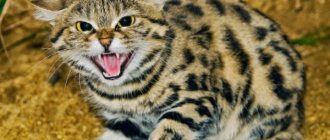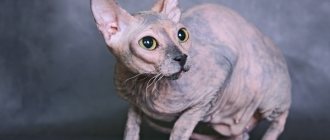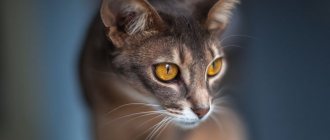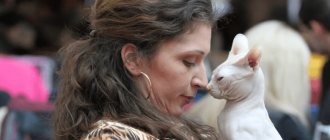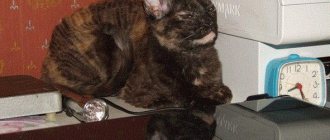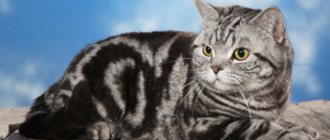Main criteria
The breeds presented below are generally recognized by all organizations.
Features of wool
Depending on the length of the coat there are:
- long-haired (coat length about 15 cm) - this group includes Persians, Burmese and Siberians;
- shorthaired - Egyptian, Chartreuse, blue;
- with curly or kinky hair - German and Cornish Rex;
- wire-haired - American;
- hairless - sphinx, bambino.
Color
In addition to the length of the coat, color is also important:
- tortoiseshell – Persians, bobtail;
- spotted - chinchilla, American with short fur;
- single color - Havana and Korat;
- two-color – ragdoll, Norwegian forest;
- motley - angora.
Drawing
In addition to the color of the fur coat, which can combine several colors, types are distinguished according to the type of pattern:
- solid – gray, black, red;
- zonal – spotted, striped;
- white – representatives of this species have a white color with spots of various colors and shades on the coat;
- silver – smoky, cameo;
- color point - the body is darker in color, and the paws are slightly lighter.
Body features and body shape
This parameter divides all breeds into 6 types:
- Stocky or cobby. The most prominent representatives of the species are exotics and manxes. Their legs are short, their neck is shortened, and their sternum is widened.
- Heavy breeds with a powerful body. These are Maine Coons, Siberians. Individuals have massive paws, a short neck, and their tail is also distinguished by its power.
- Semi-foreign - this group includes the Russian Blue and the American Longhair. This type is the most common. Representatives of the species have average body parameters.
- Semi-cobby - British Shorthair. Outwardly, the individuals are similar to semi-foreign cats, but they are a little stockier.
- Oriental view. Representatives: Siamese, Balinese. Oriental cats are characterized by a graceful, elegant physique, the tail and paws are long, the muzzle has a narrowed shape at the nose.
- Foreigners are Abyssinians. Cats are distinguished by an elongated tail, a wedge-shaped head, and pronounced muscles. The ears are elongated, but this feature is not mandatory.
These parameters are considered the main ones for dividing all representatives of the cat world into separate species.
Now we come to the main point!
Only larger organizations that unite clubs can determine whether a new breed is officially recognized or not. This is how new cat breeds are created.
Associations determine whether the number of individuals of a new breed is sufficient to recognize the breed. Monitors compliance with the breed standard and the correctness of its description. And all questions regarding exhibitions (can it be held, when, where, start time, order of holding) are also in the hands of associations.
Now we have figured out how new breeds are officially recognized. It would seem that there should be nothing complicated further: we take all the known old ones, add registered new ones to them - and we have a complete list of breeds. But it was not there! The main difficulty is that there are a lot of organizations responsible for the standard. This includes about ten well-known international associations, such as WCF or CFA. And smaller regional ones.
Plus there are organizations built on outright deception: they do not care about quality issues, they are only interested in the money that can be collected from gullible newcomers! And for all these associations the number of breeds registered is different.
Little fluffies, each one is unique
Therefore, it is impossible to say exactly how many cat breeds there are currently. About 70 are registered with WCF.
It must be remembered that breeding new breeds is painstaking work carried out by professional breeders. Do not fall for the tricks of scammers: if you want to purchase a purebred animal, carefully check the clubs, documents, and study the breed standard.
Naturally, our love for furry, purring pets does not depend on the presence of some kind of piece of paper, but supporting people who deceive people who profit from the buyer’s ignorance of breeds and the rules for purchasing purebred animals is unacceptable!
Emblems of the most famous felinologist organizations
The Adobe Flash Player is required for video playback.Get the latest Flash Player or Watch this video on YouTube.
Only a cat that has a pedigree can be considered a truly purebred animal.
Pedigrees are issued by special clubs of cat lovers. Clubs unite into felinological organizations. Each nursery of purebred cats must be registered with one or more such organizations.
It is important to understand the difference between a club and an association of felinologists. Clubs and nurseries are mainly engaged in breeding animals, improving their breed qualities - exterior, color, character
Sometimes they introduce new breeds or color variations, but they must be approved by the large organization to which the club belongs.
These large organizations determine which breeds can be recognized as existing and how cats belonging to them are assessed. All parameters that the animal must meet are also described by felinological associations. In addition, they are in charge of all cat shows, the time and order of their holding.
The difficulty lies in the fact that there are not one or two such organizations - there are many of them.
In addition to a dozen international ones that enjoy honor and respect in any country, there are also many small, “homemade” associations that base their work mainly on deceiving newcomers. Therefore, it is better for nurseries and buyers to cooperate with well-known associations.
This is why it is difficult to unambiguously answer the question of how many cat breeds exist in the world - each association has its own views on this, its own list of recognized breeds.
If we talk about the most prestigious organizations, the WCF has about 70 cat breeds, and the CFA has a little more than forty
. In addition, there is a significant difference in the colors of different breeds, of which there are more recognized in some places and fewer in others.
The emergence of new breeds is a labor-intensive task, since it is necessary not only to achieve stability of the acquired characteristics, but also to wait for recognition in prestigious cat associations, and they are distinguished by a certain conservatism. Oddly enough, it is the American systems that turn out to be more strict in this matter, although in other respects they keep up with the times.
Unfortunately, playing on human gullibility and lack of information, many scammers pass off ordinary yard cats as true aristocrats. For example, they offer to buy “a kitten of the rarest color - Abyssinian platinum.” If you decide to get a truly purebred pet, first carefully study the standards, make sure you can distinguish a purebred animal from a fake.
Of course, love is not measured by the purity of blood, but by buying so-called kittens of a rare breed (but in fact, a non-existent one), you support scammers who, without hesitation, throw unsold kittens into the trash heap, and continue this conveyor belt of death for their own benefit.
A real breeder who is passionate about his business takes care of his pets, monitors their lives in their new homes, and is always ready to give advice and help. Such people are busy doing a wonderful job - they improve breeds and create new ones, delighting all cat lovers.
The Global Footprint Network estimates that there are about 600 million small cats in the world. This includes domestic cats, stray cats and feral cats. There are about 100 million wild cat species alone, which means there are about 500 million domestic and stray cats on Earth.
All over the world, cats are the most popular pets. With the exception of Antarctica, they are found on all continents and most islands of the planet. Depending on the source of classification, there are between 39 and 49 breeds of domestic cat.
More than 10,000 years ago in the Middle East, the first domesticated cats helped people control pests. The ancestors of the domestic cat began to live near people, feeding on human enemies such as. During the 1940s, cats became full-fledged pets, and cat litter was invented to provide a complete transition to their new role.
Cats are considered the most common domesticated animals. Indeed, there are so many of them that each person can choose the right cat for themselves. They are all unique and amazing creatures. For any color, size, with or without fur... Many people are interested in the question, how many breeds of cats exist in the whole world?
Purebred cat - who is she?
The number of purebred cats is small - only 3% of all domestic pets. To become the chosen one, you need to go through several stages:
1. Obtaining experimental status is the first step;
2. Obtaining the status “without a champion”, when the purr can take part in exhibitions for the sake of advertising, but cannot receive various titles and awards;
3. Final recognition – champion status with all privileges. In one of the most authoritative cat organizations, WCF, there are about 70 such breeds, in others there are more.
The presence of a pedigree is one of the main confirmations of the breed. This important document is issued by the specialized Cat Lovers Club, which is part of the felinological organization.
A purebred cat must pass on to its offspring the characteristics characteristic of this breed. Large “cat” organizations identify these differences and, based on them, create a standard that describes the distinctive features of this type of cat: head shape, eye color, body length, type of coat and its color, as well as other characteristics. The standard must specify the breed's shortcomings, as well as what external signs may lead to disqualification.
Also, felinological organizations are involved in planning and holding cat exhibitions.
By the way, the first such official exhibition was held in England in 1871. The public was delighted with what they saw - blue Britons, Persian and Siamese cats, extraordinary Turkish Angoras and other mustaches showed off in front of those around them. Thus, the term “breed” acquired a new meaning - people were able to learn more about their pets and their characteristics. After this event, new “cat” clubs and associations began to emerge.
Types of cats
To find out how many cat breeds currently exist in the world, you need to look at the list of varieties that are recognized by the three largest felinological organizations (WCF, FIFe and TICA):
- 1. Maine Coon.
- 2. Egyptian Mau.
- 3. Abyssinian.
- 4. Peterbald.
- 5. Balinese (Balinese, Bally).
- 6. Siamese.
- 7. Burma (Burmanskaya).
- 8. Cymric.
- 9. Persian (Kolopoint). TICA distinguishes 2 types: Persian and colorpoint, while others consider this to be one cat breed.
- 10. Sacred Burmese.
- 11. Oriental DS.
- 12. Oriental CABG.
- 13. Exotic.
- 14. Norwegian forest.
- 15. Korat.
- 16. American Curl DS.
- 17. American Curl KSh.
- 18. Siberian.
- 19. Kurilian bobtail DS.
- 20. Kurilian bobtail KSh.
- 21. British KS.
- 22. Don Sphynx.
- 23. Devon Rex.
- 24. Manx (Manx cat).
- 25. Cornish Rex.
- 26. Ocicat.
- 27. Russian blue.
- 28. Japanese bobtail DS.
- 29. Japanese bobtail KSh.
- 30. Ragdoll.
- 31. Somalia.
- 32. Bengal.
- 33. Turkish Angora.
- 34. Turkish van.
- 35. Neva Masquerade.
- 36. Canadian Sphynx.
- 37. Chartreuse.
To obtain registration of a cat variety, it is necessary to prove the “right to exist.”
Therefore, recognition takes time.
Organizations may disagree. This leads to the fact that some cat breeds are recognized only by separate groups, and the total number fluctuates:
- WCF considers such varieties as Australian Mist, Tabby (Asian), Anatolian, Arabian Mau, Brazilian KSh, York, Canaani, Karelian Bobtail KSh and DSh, Mekong Bobtail, Ragamuffin, Scottie Straight, Chantilly Tiffany, Ural Rex DSh and KSh. These species are not registered in TICA and FIFe.
- TICA recognizes the following: Minskin, Ojos Azules and Ojos Azules DS, American Bobtail DS and CS, Havana, Pixie Bob CS and DS, Savannah, Serengeti, Toyger and Javanese. WCF and FIFe do not consider these breeds.
- FIFe recognizes Seychelles DS and KS, which others do not allow for registration.
Counting all the cats living on our planet is as difficult as counting the stars in the sky. There is approximate information about how many cats there are in the world. And then, only domestic cats are taken into account, and their wild species, poor things, are without stable statistics.
Felinological organizations
On the website of each association you can see what standards exist and what should be a prerequisite for a particular breed. This information is published so that animal owners do not fall for the tricks of unscrupulous people who pass off a mixture of a Persian cat and an Abyssinian cat as “unique.” Nowadays this phenomenon is in fashion, and some breeds bred in this way are called “designer”. But they can ask for a large amount of money.
READ How to care for a cat? Cat care
In any case, when purchasing, you must always ask for a pedigree; without it, the cat cannot be considered purebred.
Organizations existing today:
- WCF is the most famous, allowing 70 varieties of cats, 9 new ones (which includes Savannah, Tiffany, Bristol, York Chocolate and others), “no species” (domestic), and not yet recognized unregistered ones;
- FIFe has 51 cat breeds;
- TICA speaks of 73, “mongrel”, 3 practically recognized (Serengeti, Highlander DS (longhair) and Highlander KSH (shorthair), one provisionally recognized (Minskin);
- The CFA has “legalized” just over 40 varieties of pets;
- Others: GCCF, International Feline Association (IFA), ICU, Assolux, WACC, ASC, AFC and FARUS.
Bengal cat
The breed was created by crossing a domestic cat with a wild leopard cat. The Bengal cat is large, slender, very muscular, with a thick, low tail. The wild appearance is enhanced by the characteristic thick spotted or marbled hair coat. She has a wide head, small ears, and almond-shaped eyes with a black border. The tail is thick, tapering with a black tip. No other breed of cat has such shiny golden-pearl fur (shine effect) as Bengal cats. These beauties get very used to their caregivers. They love human company, as well as children. Bengal cats get along well with other animals. They are smart and active.
| Bengal breed size chart | |||
| Height at withers (cm) | Body length(cm) | Weight, kg) | |
| Cat | 32 | 90 | 7,5 |
| Cat | 26 | 75 | 6 |
| Kitten (3 months) | 1,8 |
Kittens should get enough nutrients and vitamins in their food. Then the animal grows and gains weight gradually. After a week of life, the weight doubles, and after a month it slows down a little. Until the age of 2, the kitten only grows, and weight gain actually stops.
Only a cat that has a pedigree can be considered a truly purebred animal.
Pedigrees are issued by special clubs of cat lovers. Clubs unite into felinological organizations. Each nursery of purebred cats must be registered with one or more such organizations.
It is important to understand the difference between a club and an association of felinologists. Clubs and nurseries are mainly engaged in breeding animals, improving their breed qualities - exterior, color, character
Sometimes they introduce new breeds or color variations, but they must be approved by the large organization to which the club belongs.
These large organizations determine which breeds can be recognized as existing and how cats belonging to them are assessed. All parameters that the animal must meet are also described by felinological associations. In addition, they are in charge of all cat shows, the time and order of their holding.
The difficulty lies in the fact that there are not one or two such organizations - there are many of them.
In addition to a dozen international ones that enjoy honor and respect in any country, there are also many small, “homemade” associations that base their work mainly on deceiving newcomers. Therefore, it is better for nurseries and buyers to cooperate with well-known associations.
Among the European ones, the most authoritative and oldest is the World Cat Federation (WCF), among the American ones - The Cat Fanciers' Association (CFA).
This is why it is difficult to unambiguously answer the question of how many cat breeds exist in the world - each association has its own views on this, its own list of recognized breeds.
If we talk about the most prestigious organizations, the WCF has about 70 cat breeds, and the CFA has a little more than forty. In addition, there is a significant difference in the colors of different breeds, of which there are more recognized in some places and fewer in others.
The emergence of new breeds is a labor-intensive task, since it is necessary not only to achieve stability of the acquired characteristics, but also to wait for recognition in prestigious cat associations, and they are distinguished by a certain conservatism. Oddly enough, it is the American systems that turn out to be more strict in this matter, although in other respects they keep up with the times.
Unfortunately, playing on human gullibility and lack of information, many scammers pass off ordinary yard cats as true aristocrats. For example, they offer to buy “a kitten of the rarest color - Abyssinian platinum.” If you decide to get a truly purebred pet, first carefully study the standards, make sure you can distinguish a purebred animal from a fake.
Of course, love is not measured by the purity of blood, but by buying so-called kittens of a rare breed (but in fact, a non-existent one), you support scammers who, without hesitation, throw unsold kittens into the trash heap, and continue this conveyor belt of death for their own benefit.
A real breeder who is passionate about his business takes care of his pets, monitors their lives in their new homes, and is always ready to give advice and help. Such people are busy doing a wonderful job - they improve breeds and create new ones, delighting all cat lovers.
Cat character
Sometimes people pay attention to the cat’s character. There are animals that are said to be of good character and independent. Those cats that are considered docile are playful, sociable, and affectionate. And those with an independent character are true representatives - “a cat that walks on its own.” They are proud, proud, and often consider themselves mistresses of the house...
The ancestor of all cats in the world was a steppe species (according to another version - a forest one), which began to be domesticated 12,000 years ago. It was from then on that selection arose, during which an animal acquired certain traits beneficial to humans and lost others. Now it is difficult to answer how many breeds of cats exist in the world, but it is possible to understand this issue.
The uncertainty in the number of breeds occurs due to the fact that there are simultaneously 3 largest felinological organizations in the world:
- WCF is the World Federation, the largest and most authoritative at the moment. It was founded in 1988 in Rio de Janeiro and has more than 540 clubs.
- FIFe is one of the participants of the World Felinological Congress. Created in 1950 in Belgium.
- TICA is an International Association, founded in 1979 in the USA, but later acquired an international format.
The main difficulty is that these organizations do not register and recognize breeds at the same time. Most often this happens over time, but sometimes a species recognized by one organization is never confirmed by others. In addition, several breeds are constantly at the stage of preparation and documentation.
Each organization applies its own criteria and parameters to determine purebredness. Most often these criteria are:
- body shape and body proportions;
- eye color;
- temperament and character;
- characteristics of wool;
- health characteristics, etc.
Currently the most varieties are registered in the WCF: about 74, 9 of which are recently registered. FIFe and TICA declare 51 and 73 varieties respectively.
Description of the main breeds
The main types of cats were derived from the earliest, but not always the most widespread, breeds. And now breeders continue to experiment with these species, achieving new results.
- British.
They became the founders of two main lines: British Longhair and Shorthair, the older of which is the Shorthair. Both species are characterized by ideal hair, which is very easy to care for: it does not mat and does not shed as actively as other representatives of the cat world. - .
Their color resembles wild rabbits, which is why they got their first name - “rabbit cats”. Very easy-going, with a good disposition and graceful body. - Scottish.
There are 2 main forms - straight-eared and lop-eared. The basic one was straight-eared, and lop-eared was the result of genetic experiments, during which it was possible to fix the gene responsible for the regression of cartilage tissue. - American Curl.
The main distinguishing feature is the ears, which bend inward or backward at different angles. The inner surface of the auricle is densely pubescent. American Curls are very active animals; their playfulness and activity remain in them until old age. - European Shorthair.
Experts believe that this breed was formed with minimal human intervention. It is quite difficult for a non-professional to distinguish these cats from ordinary yard cats, since they are as close as possible in genotype and appearance. - Angora.
There is an opinion that she became the predecessor for all long-haired pedigree groups. A distinctive feature is the absence of undercoat and a thick collar around the neck. - Egyptian Mau.
Of all the species currently known, the Mau is the most ancient. Her image was first drawn 3 thousand years ago. Her eyes look very unusual: they seem to be lined with eyeliner, and a “W” pattern is visible between her ears.
The question of the number of cat breeds still remains unresolved, since the system of characteristics of varieties in different associations is not the same. There are 4 main felinological organizations in the world, as well as 8 large and several small ones. Only these associations have the right to register a new breed. There are different methods for identifying new cat varieties within each organization, which is why the number of “legalized” breeds fluctuates.
Main breeds
Breeders regularly present unique varieties to the public. No one knows how many cat breeds there are in total. There are not so many main varieties; the rest are considered their derivatives:
- Abyssinians. Very graceful and graceful cats, often reminiscent of rabbits in color. They have a good affectionate character;
- British. There are long-haired and short-haired. The absence of shedding is considered a big advantage;
- European shorthair. They are easy to care for and have many variations in coat color and body type. Considered one of the most common breeds;
- angora. These cats are easily recognized by their thick, silky fur, with virtually no undercoat. It is believed that they became the predecessors of all cats with long hair;
- The Sphynx is an original breed, characterized by severe underdevelopment or complete absence of fur. Affectionate and flexible, gets along well with children;
- Egyptian Mau. A distinctive feature is the pattern between the ears in the shape of the letter “w” and the eyes beautifully framed by dark fur.
These varieties are considered the main ones, and most breeders work with them, achieving the appearance of original individuals. Priority tasks are improving the exterior, obtaining new coat patterns and colors. Completely new breeds of cats do not appear so often; the final word always remains with large official structures, which are guided by their own standards that clearly describe the characteristics of each specific variety.
What is a purebred cat
A breed is a group of animals that differ from other members of a family or species by a set of certain characteristics. It is clear that for each of us who is the happy owner of a funny furry animal, it makes no difference what breed it is. We just love him, and pedigree has nothing to do with it.
A cat is classified as a specific breed if it has and passes on to its offspring traits characteristic of that breed.
Pedigree Compliance with standards No disqualifying characteristics Pedigree refers to documents issued by the relevant club. It can exist only in one case - if the cat is a carrier of all the genetic characteristics of its breed, which are passed on from generation to generation. The pedigree includes a description of the parents. This refers to external signs, thanks to which you can accurately determine whether an animal belongs to a particular breed. There are quite a lot of such factors: head shape; the structure and length of the ears; body length; coat length or lack thereof; coat color; eye color; tail length and position. In addition to these signs, there are many more secondary ones. So matching the breed is not such an easy task for a pet.
The description of the standards necessarily includes positions in which a cat cannot be considered a purebred cat. These are the so-called disqualifying characteristics. For example, an animal is considered purebred, but its ear structure or face shape is different, its color is disturbed, etc.
This is mainly a consequence of mating with a mongrel or genetic abnormalities. It is important to understand that not all deviations from accepted breed standards can cause disqualification. Minor defects only reduce the value of the item
This is usually expressed in a reduction in price. Existing defects must be indicated in the documents.
How many cat breeds are there?
Many felinologists ask the question about the number of elite felines on earth, since every year the number of cats that lay claim to a separate breed increases. There are several world organizations, the list of which includes more than a dozen species of cats. It is impossible to determine the exact number of cat breeds in the world, since associations register applicants at different times. It is possible that one livestock association will approve a new species, but another will not. There are three respected groups of organizations which include:
According to the organization TICA, there are only 73 species of these furry animals in the world.
- W.F.C. Registered in 1988, it is the most authoritative and has about 540 clubs around the world. It officially recognized 74 breeds, including 9 newly approved ones.
- FIFe. A participant in the World Felinological Congress was formed in the 50s of the last century. In its series it includes 51 species of cats.
- TICA. The International Association was founded in 1979 in the vastness of the USA. In the process of development it acquired international status. She officially approved 73 varieties of cats.
When checking whether a cat’s breed is a recognized one, they check with all lists of felinological organizations.
There are many cats in the world that differ in body type, structure and color of fur, as well as the pattern located on it. Animal lovers formed associations that divided cats into breeds and endowed each with a certain set of characteristics. When the kitten reaches 3 months of age, it is checked for defects and assigned to one or another variety.
How many species of cats are there in the world?
It is not possible to count all the cats living on Earth, if only because they constantly reproduce and die. With long or short hair, large or small, with a round or wedge-shaped muzzle, with or without a tail - each variety includes an innumerable number of individuals. From the article we will find out how many cats there are in the world: wild, domestic and purebred.
- Wild cats
- Domestic (mongrel) cats
- Pedigree cats
- Standards
Wild cats
It is also impossible to determine how many cats are in the wild on planet Earth. Their representatives live on all continents except Antarctica. Some species have fully adapted to being close to humans.
Thus, the lynx totals about a million individuals in the world. But some cat populations are dying out before our eyes, despite constant offspring, and therefore it is difficult to say exactly how many cats there are on earth.
This is due to human activity and environmental degradation.
shutterstock
There is such data on endangered species.
- lion - currently lives less than 20 thousand;
- cheetah - less than 15 thousand;
- tiger - no more than 6 thousand;
- Asian leopard - approximately 100 individuals;
- snow leopard - a snow leopard with the most beautiful fur in the world - less than 100 individuals;
- white lion - several dozen.
Domestic (mongrel) cats
Studies have been conducted that have shown that over 400 million cats are kept at home. An adult cat gives birth to up to seven kittens at a time.
Not all owners limit the breeding of ordinary cats. Village pets regularly bear offspring about three times a year.
Only the reproduction of purebred individuals is constantly monitored, and therefore the number of cats in the world is difficult to accurately calculate.
The number of stray cats in populated areas around the world cannot be counted. Stray animals live near markets and warehouses, in the basements of residential buildings, and sometimes in garbage dumps.
Pedigree cats
Today there are quite a few cat breeds. These animals were first bred in Asia. Breeds have always been registered by International Phenological Universities. They also monitor the purity of the breed.
There are 40 breeds officially registered by the American Association. Of all domestic cats, only 3% are purebred.
What is meant by thoroughbred? First of all, specific exterior characteristics:
- unique color and pattern;
- presence or absence of wool and its type;
- length of body, tail and paws;
- weight;
- skull shape;
- structure of the ears;
- chest width;
- eye color type.
shutterstock
There are also secondary signs, for example, features and habits. It is possible to confirm that a cat is a representative of a particular breed only with the appropriate document. It is issued to every phenologically typical purebred animal. For cats, the supporting document is a pedigree, and for newborns, a certificate.
Standards
For each cat breed there are standards drawn up by the Association of Felinologists. The standard specifies all primary and secondary requirements and possible deficiencies. The standard explains which conformation characteristics are grounds for disqualification. The variety of breeds is great.
There are a large number of wool types alone:
- shorthair: Thai cat, British cat and many others;
- long-haired: Persian cat, Siberian and others;
- hairless cats: Donskaya, St. Petersburg and Canadian Sphynx, Ukrainian Levkoy.
Take as the basis for the classification of cats and sizes:
- small, weighing within four kilograms: toy bob, balinese, minskin and others;
- large (up to 15 kg): bob-tails, Maine Coon, Turkish Van, Chausie, Siberian, Norwegian Forest.
In all countries of the world, clubs require owners of purebred animals to approve each mating, as they monitor their frequency. Pre-registration is required for expensive cats, although not everyone can afford them. Mating of these cat breeds is not carried out just like that, without an order.
Unfortunately, even the World Cat Congress does not name the exact number of purebred cats. After all, each individual Association and each club maintains its own records of purebred cats, and the number of cats on the list of one organization may not coincide with the list of another. So, from the article the reader learned that there are approximately 40 breeds of cats in the world and they are all different in standards and classification.
Pedigree cats
Today there are quite a few cat breeds. These animals were first bred in Asia. Breeds have always been registered by International Phenological Universities. They also monitor the purity of the breed. There are 40 breeds officially registered by the American Association. Of all domestic cats, only 3% are purebred. What is meant by thoroughbred? First of all, specific exterior characteristics :
- unique color and pattern;
- presence or absence of wool and its type;
- length of body, tail and paws;
- weight;
- skull shape;
- structure of the ears;
- chest width;
- eye color type.
© shutterstock
There are also secondary signs, for example, features and habits. It is possible to confirm that a cat is a representative of a particular breed only with the appropriate document. It is issued to every phenologically typical purebred animal. For cats, the supporting document is a pedigree, and for newborns, a certificate.
How many cat breeds are there in the world?
Cats are considered the most common domesticated animals. Indeed, there are so many of them that each person can choose the right cat for themselves. They are all unique and amazing creatures. For any color, size, with or without fur... Many people are interested in the question, how many breeds of cats exist in the whole world?
Who can answer this question?
Of course, today in the Internet world you can enter this question into a search engine, and you will be shown entire lists of various cat breeds. However, they may not be entirely accurate, because in practice, even the most experienced specialist will not be able to indicate the exact figure.
Moreover, a lot of disputes have been held between breeders about their breeds, because many cats have existed for a long time, but are still not officially recognized.
Naturally, such a process is very serious, otherwise anyone could cross two pets and demand that their offspring be registered as a new species of kittens. For example, all pet lovers know the mixed breed cat, but some people who have formed their own circles claim that they have a different name - a designer breed.
Therefore, special organizations deal with this issue.
Many lovers of furry four-legged animals are concerned with the same questions: what breeds of cats are there? What breed is the most common? How do new animal species appear? However, let's first deal with another issue.


